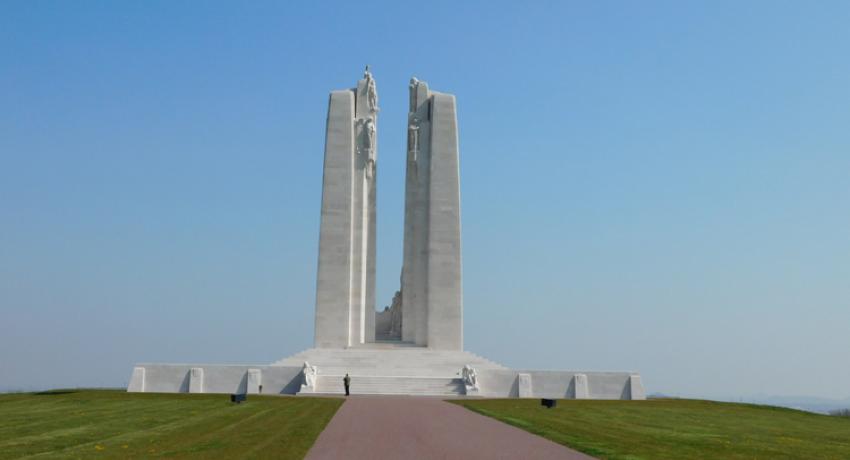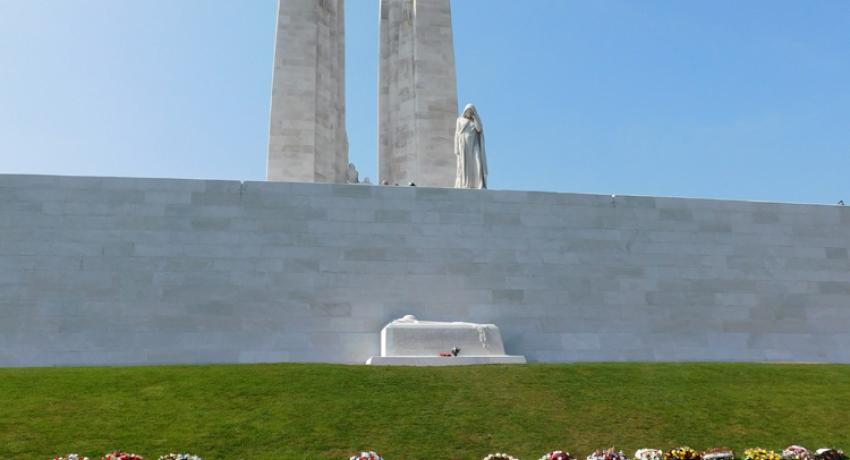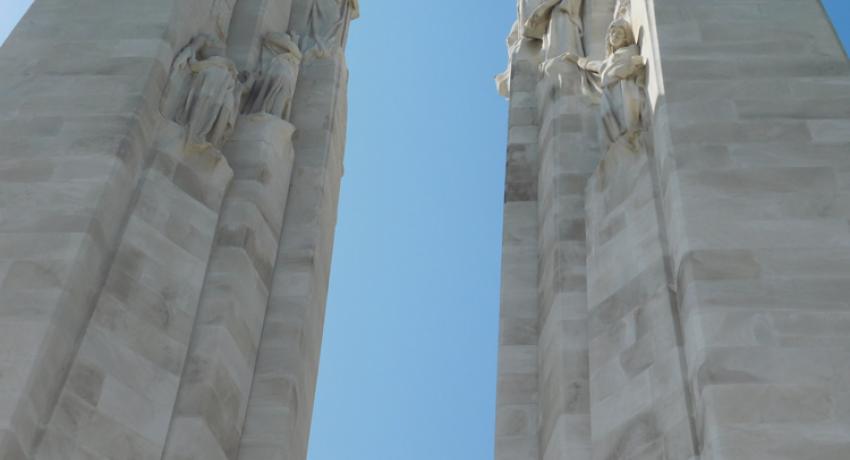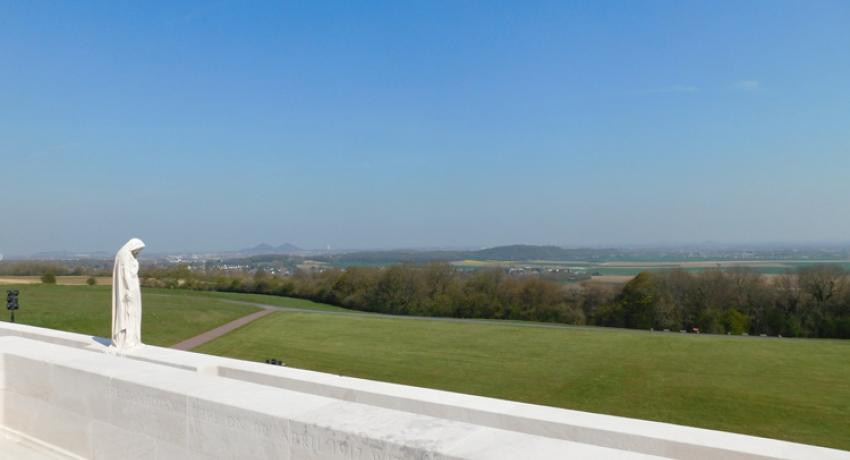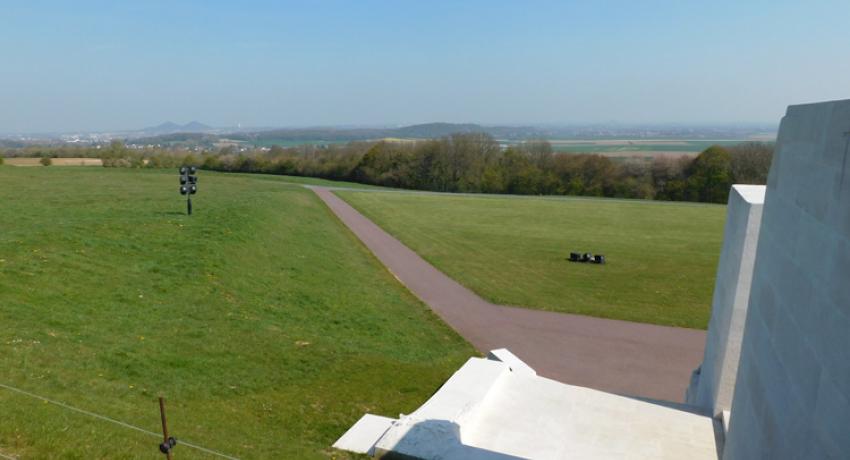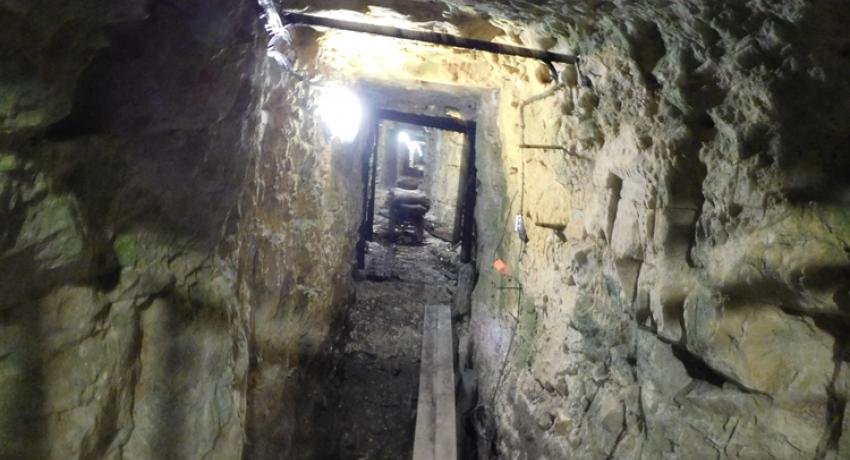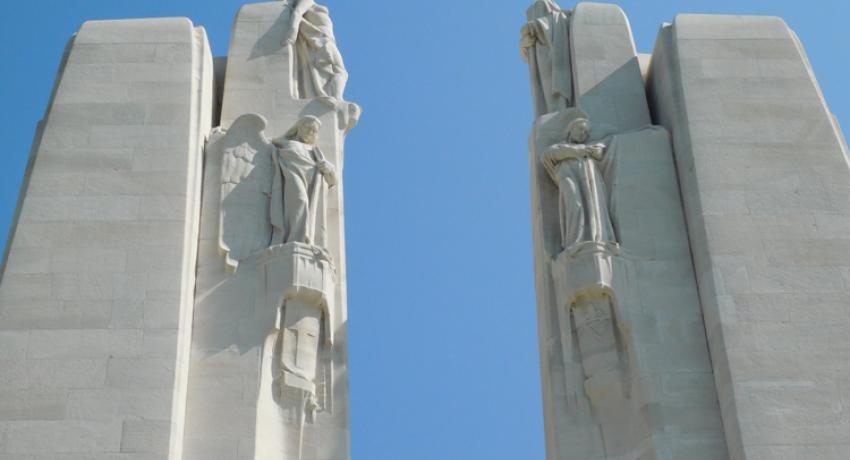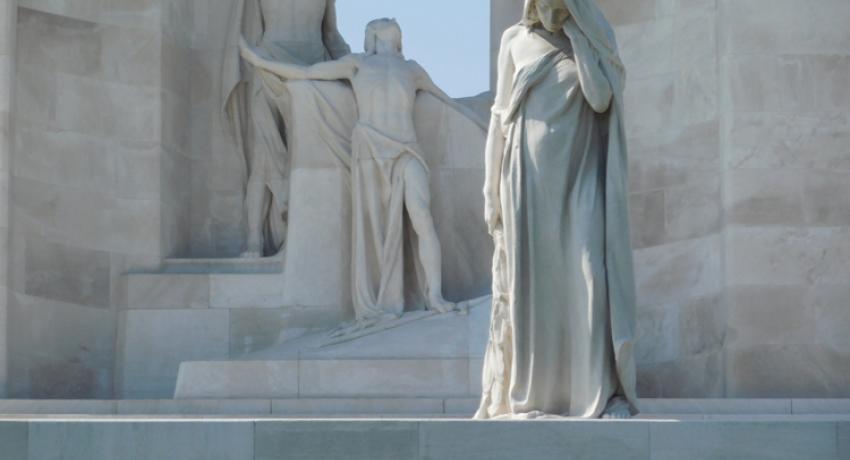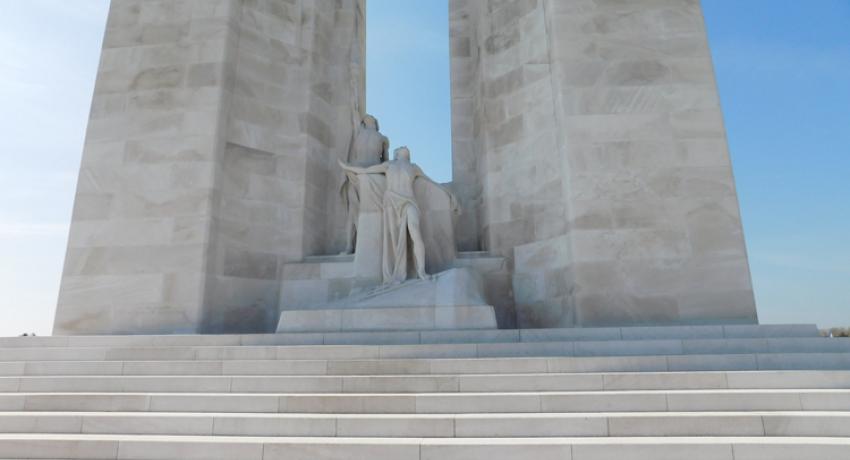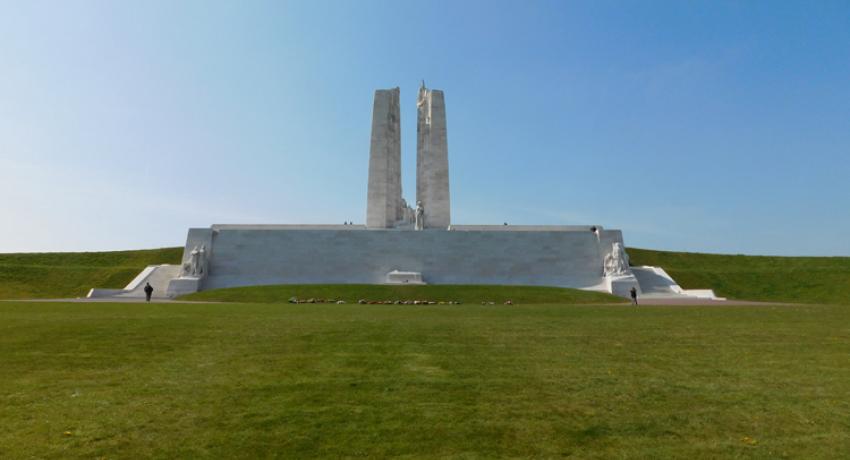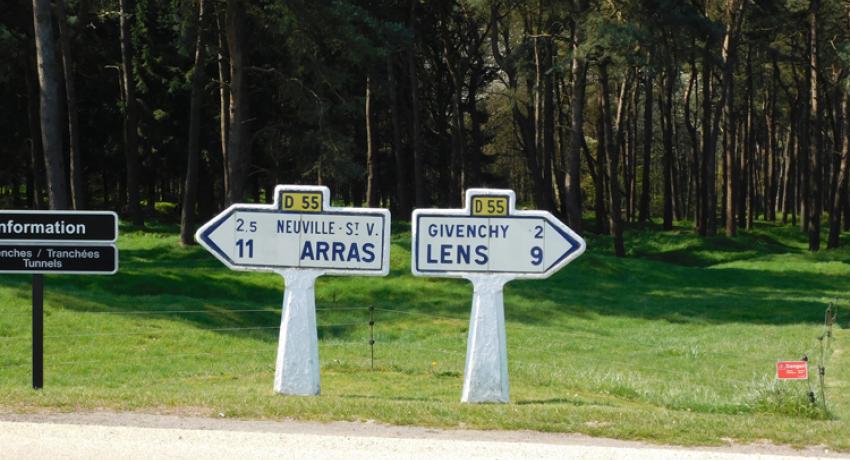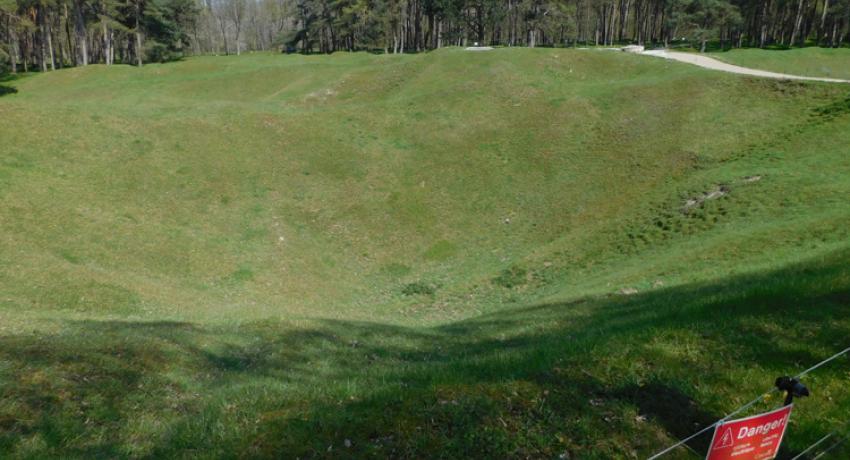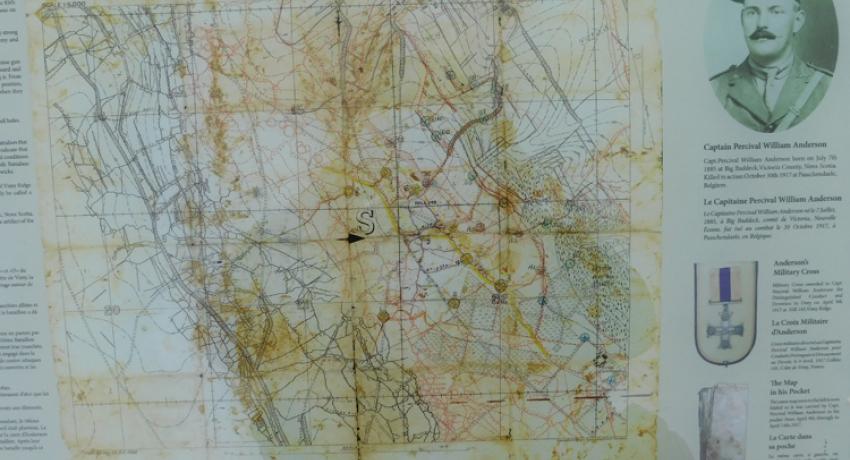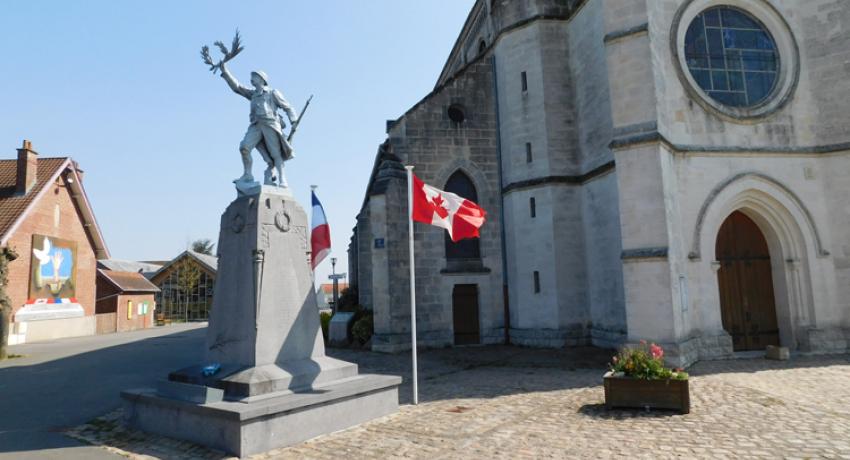CANADA'S NATIONAL VIMY MEMORIAL
This memorial is dedicated to those men of the Canadian Corps who lost their lives during the First World War. It is also a place of commemoration, honour and remembrance for the men of the Canadian Corps that were killed or are missing and have no known grave. The site covers 250 acres in a park like setting and takes in part of the ground the Canadians advanced over on their day of victory on April 9, 1917. This monument has become a national Canadian symbol of achievement and sacrifice.
Vimy Ridge itself is a gently rising from the western side until at the eastern side there is a steep slope overlooking the Douai Plain. The ridge is 4 miles long and less than a half mile wide at the most narrow point and it rises 200 feet above the plain.
Many historians and military people have said that the astounding victory by the Canadian Corps was the moment that Canada became a nation but I am one who does not agree with this statement. Go to the blog entitled TWO GENERALS BRING CANADA TO NATIONHOOD.
The Canadians arrived in the Somme late in August 1916 and from that time until the middle of November they had but one success and that was at Flers-Courcelette. During this period the Allied losses were astronomical due to the fact that the British way of conducting a war was very simple and no thought of the consequences went into the planning of an assault. The life of any human being met nothing to General Haig who was the British Commander. Day after day and month after month there were frontal assaults and these assaults were conducted with little planning, no imagination, no strategy and as a result the losses mounted, the assaults continued to fail and objectives were rarely taken. The Canadian Corps were watching and all the while the Canadians were learning. The commanders, especially Currie, was not going to let what was happening to the British and French forces happen the the men of the Canadian Corps when he became Commander.
Both the British and French had tried to capture the ridge and their losses were 150,000 men when Haig ordered the Canadians to take the ridge in the spring of 1917 and they did so in one day and it took them another two days to fully secure the whole area.
The Germans had captured Vimy Ridge very early in the war and over time had transformed it into a very formidable defensive strong point which included a very extensive system of tunnels and trenches manned by highly trained soldiers with many machine guns, mortars and artillery.
During the winter of 1916-1917 the Canadian now on the front lines at Vimy across from the enemy forces spent the whole period and they strengthened their lines, preparing and planning the assault and carrying on with very extensive training. Models of the enemy trench system were made and the soldiers were drilled over and over on what they had to do to achieve success during the assault. The infantry were given the roles of specialists in machine guns, riflemen and grenade-throwers. Canadian soldiers even raided enemy positions to gather much needed and important intelligence.
There was very extensive mining underneath the German lines and set up large caches of explosives that would be detonated when the attacks moved forward. Elaborate tunnel systems with light rail, piped water, lights and huge underground bunkers to stockpile the much needed supplies and arms were constructed to aid the Canadian Corps.
The Canadian Corps artillery softened up the enemy during the week prior to the attacks by means of a massive and prolonged artillery barrage. They did this to avoid giving the enemy any hint as to when the attack would take place. During this week the artillery of the Canadian Corps brought down 1,000,000+ shells onto the enemy positions. The Germans referred to this week as "the week of suffering".
The Allied aircraft cleared the skies of enemy aircraft and observation balloons.
Sir Julien Byng the Commander of the Canadian Corps was quoted as saying "Chaps, you shall go over exactly like a railroad train, on time, or you shall be annihilated".
On Easter Monday, April 9, 1917, at 5:30 am 1,000+ pieces of artillery of all calibers opened up on the enemy positions and continued firing for an hour until 6:30 am.
At 6:30 am the heavily laden Canadian soldiers began to follow their "creeping barrage". The assault had begun onto Vimy Ridge in the wind, rain, snow and sleet.
As they followed the artillery barrage they faced enemy machine gun fire and as they advanced they were able to capture enemy positions in the first critical moments of the assault before the enemy could emerge from their underground bunkers.
The first attacking waves of the advancing Canadians suffered heavy casualties but this did not slow the advance down at all. The Canadians then went on to capture the majority of the heavily armed ridge by noon on April 9th.
Hill 145, the highest point on Vimy Ridge was captured during the morning of April 10th following a frontal bayonet charge and this is where the Vimy Memorial stands today. Then two days later on April 12th, the feature known as "the Pimple" was captured and the Germans were forced to retreat 2 miles to the east. At this stage the Canadian Corps now commanded the heights of Vimy Ridge overlooking the Douai Plain.
The success of the Canadian Corps in the four day battle for control of Vimy Ridge can be attributed to the fact that Generals Byng and Currie were not at all shy about attempting new tactical innovations to achieve success. They prepared their artillery, the infantry and the engineers with very sound and meticulous planning and thorough preparation. They cared for the men under their command and they tried their best to keep the casualty count as low as possible. And they succeeded.
The British XVII Corps on the Canadian Corps immediate southern flank advanced further and captured more enemy equipment that any unit in previous assaults by the British Expeditionary Force.
The capture of Vimy Ridge by the Canadian Corps was essential to the advance of the British Third Army to the south and of extreme importance to checking the German attacks in the following year (1918).
The Canadian Corps had proven themselves to be the outstanding formation on the Western Front and masters of offensive warfare. They showed with very sound planning combined with foolproof strategy that no enemy position was now secure from a Canadian Corps attack.
The number of Canadians involved in the assault upon Vimy Ridge was 100,000. The losses of the Canadian Corps during the battle for Vimy Ridge were 10,602 with 3,598 being killed.
ST JULIEN CANADIAN MEMORIAL
This memorial sits on soil from Canada and is surrounded by tall cedar trees trimmed into the shape of large artillery shells and low cedars trimmed to look like exploding shells. As well there are lawns and beds of flowers. The granite from this memorial is from Canada and is 35 feet high and is known as the St Julien Memorial or the Brooding Soldier Memorial. It rises from a flagstone terrace.
This Memorial stands guard for those Canadians who died during the stand against the enemy when gas was first used. The top of the Memorial is the head and shoulders of a Canadian soldier with folded hands resting on arms reversed. He is facing the direction from which the gas came and the expression on his face below the steel helmet is determined and unwavering and at the same time he is sympathetic, as though he is meditating on the battle where his comrades displayed so much courage.
The inscription reads "This Column Marks The Battlefield Where 18,000 Canadians On The British Left Withstood The First German Gas Attacks The 22nd Of April 1915 2,000 Fell And Here Lie Buried".
When the enemy first used gas it was the beginning of a new era of war that was full of terror. The Canadians, on April 22, 1915, in the face of extreme danger fought back and did not break and this ensured that the war did not suddenly turn in favour of the Germans.
During World War I, St Julien was in the Ypres Salinet which was a part of the Allied front that bulged into the enemy lines and as a result Ypres was surrounded on the north, south and east by the Germans.
The German Command believed that by using gas the stalemate on the Western Front would end and in addition the German military was now short of munitions and the use of gas would work in their favour. On April 22nd, the enemy was shelling Ypres with their artillery and howitzers and then suddenly in the late afternoon their guns fell silent. About 5 pm the wind was blowing into the faces of the Allied lines. Again the enemy artillery became active but this time onto the French lines and then shifted to the Canadian lines and then onto Ypres. This was the signal along with a single red flare for the gas to be released.
The French were able to hear the hiss of the gas across "no man's land" being released from 6,000 cannisters containing 180,000 kilograms of liquid gas and as the gas was released across a front of 6 miles it turned a yellow green cloud and very quickly the French had been overcome. Within a few short minutes 5,000 French soldiers were dead, 2,000 were captured and another 3,000 fled in panic. The enemy infantry was advancing wearing primitive gas masks behind the gas and rapidly pushed two miles into the salient. At this point they stopped and they dug in and prepared for French counter-attacks and all the well they had no idea if the gas was effective.
This gas attack did not affect the Canadians in a serious manner and with the enemy advancing the Canadians came under attack from captured French guns. This was now a serious threat and it was possible for the enemy to sweep in behind the Canadians and then move to take St Julien.
The Canadians and British moved to fill the gap with the hope of slowing down or stopping the enemy and now the Canadian artillery was active after the French crumble and the 1st Canadian Division knew their left faced the same threat that the French just experienced and they began to prepare themselves. In the late evening of April 22nd, the 10th & 16th Battalions advanced and forced the Germans from Kitchener's Wood which was an oak plantation located immediately west of St.Julien and over the next day which was April 23rd, the Canadians gained and held against fierce enemy counter-attacks.
On April 24th, the second gas attack by the enemy began onto the Canadian lines. As the gas was being released and began clouding a moving toward the Canadians the men were told to cover their mouth and noses with urine soaked cloths as this would neutralize the gas. When the gas arrived their was destruction within the Canadian lines. Soldiers died, soldiers became incapacitated, but enough men were still at their posts with many being half blinded, had weeping eyes, coughing violently and vomiting but they threw back the enemy advance. The enemy regrouped and advanced again and the Canadians had to withdraw from their positions and soon they would be successful in breaking the Canadian line. When the Canadians did fall back they had to leave their wounded and dying comrades who were on the ground where the gas was pooling in the low ground. The !st Division was also forced out of St Julien.
During the first two days, the Canadians were able to hold the line and 6,035 or 33% who went into battle became casualties with approximately 2,000 being killed.
The British then tried counter attacking numerous times but were not successful. This attack pattern by the enemy was forcing the Canadians back and their counter-attacks were failing. On April 25th at 3 am the left the front lines.The new front was stabilized and held by April 27th but there were attacks and counter-attacks until the battle of St Julien ended on May 4, 1915.
Germany had failed to wipe out the Ypres Salient but their attacks did reduce the amount of territory the Allies held in and around Ypres.
During this battle 69,000 Allied soldiers died, were wounded, went missing or were taken prisoner. German losses numbered 35,000 men.
HILL 62 (SANCTUARY WOOD) CANADIAN MEMORIAL
Hill 62 Canadian Memorial is made out of a block of Canadian granite that weighs 15 tonnes, and the memorial is set in a circle of green grass at the top of three landscaped terraces, each with brightly coloured beds of roses in season.
The inscription on the Memorial is "Here At Mount Sorrel On The Line From Hooge To St Eloi, The Canadian Corps Fought In Defence Of Ypres April-August 1916.
Hill 62 is surrounded by forests and is 203 feet above sea level and today as you look out over the surrounding country side you become aware of how far the thin lines of the forest extend. You can look down over Sanctuary Wood and Maple Copse and along the broad spur that is Observatory Ridge and see the spires of the churches in Ypres three miles to the east.
The 2nd and 3rd Divisions of the Canadian Corps defended this position from the enemy for five months and prevented the enemy from gaining the last few miles of Belgian territory still held by the Allies.
The Canadians initially were engaged in the southern part of the Ypres Salient and were positioned from St Eloi to just northwest of Hooge on the Ypres-Menin road, and these offensives were took place to keep the enemy occupied.
The 2nd Division, wearing the new steel helmets for the first time in battle, received their "Baptism of Fire" at St Eloi on the battlefield filled with mines and shell holes that were filled with water. Over a two week period the confused assaults and counter-attacks. The battle was for control of six water-filled mine craters. Canadian casualties numbered 1,375 men.
The 3rd Division in their first battle had a more devastating outcome, when on June 2nd, the enemy attacked to move the Allies off of Mount Sorrel just north of the Ypres-Menin Road. The enemy artillery barrage was the fiercest the Canadians had yet experienced and whole sections of their trenches were obliterated and the defending Canadians were annihilated. The Canadian infantry and the trees of Sanctuary Wood were thrown into the air by the shell explosions. While men were blown from their positions the 3rd Division fought until they were overwhelmed. The enemy advance was stopped on the evening leaving Mount Sorrel and Hills 61 & 62 in enemy hands. The next morning, June 3rd, the Canadian counter-attack failed and three days later the Germans assaulted again and captured Hooge on the Men road following the exploding of four mines.
The Canadian commander was General Byng and he was determined to take back Mount Sorrel and Hill 62. His orders were for the 1st Division under the command of Major-General Currie to carefully plan an attack which would be well supported by artillery. The Canadians thre a vicious artillery bombardment onto the German positions and the Canadian infantry attacked on June 13th, 1916 in the darkness and in the rain and wind. All the careful planning led to success with the heights being recaptured. This point would then remain in Allied hands until the spring of 1918 when the German Spring Offensive took place.
Canadian casualties were 8,430 men with 1,000 men being killed and 1,900 missing and 5,530 men being wounded.
COURCELETTE CANADIAN MEMORIAL
This Canadian Memorial is made of granite from Canada and the inscription reads "The Canadian Corps Bore A Valient Part In Forcing Back The Germans On These Slopes During The Battles Of The Somme Sept 3rd - Nov 18, 1916".
The Courcelette Canadian Memorial is surrounded by a park which is screened from the road by tall trees. There are more than ten varieties of maple trees which have been planted beside wide paths of well cared for lawns. There are few colours here to distract a person from the pleasing shades of green and it has made the park a place for meditation.
In the early days of September 1916, the Canadian Corps moved to the Somme River area from the Ypres Salient and their first attack would be part of a two army assault under the command of British commander Haig.
As the day was becoming light on September 15th, the Canadians attacked along a 2,200 yards near the village of Courcelette and for the first time advanced behind a "creeping barrage" aided by the support of tanks that were used for the first time on a battlefield. By 8 am the main objective had been taken and this was an enemy defensive position known as the Sugar Factory. The Canadians continued with their push toward the town and over the course of the day and into the next day which was September 16th numerous enemy counter attacks were repulsed. During this day, the town was consolidated and it is quite fitting that this Canadian Memorial is situated on the site where the Canadians achieved their first victory in the Somme. This Canadian attack was one of the very few Allied victories in the Somme. What was to follow in the next eleven weeks would be bitter and bloody.
The "creeping barrage" was first used by the Canadians during this battle and it was not used to try and annihilate the enemy but they instead used 1000s of Allied shells which slowly moved toward the enemy lines advancing 100 yards per lift. A lift was the advancement of the barrage in front of the attacking infantry. The barrage was not meant to destroy the enemy trenches but to force the enemy into their dugouts. The infantry would follow the barrage closely which was called "leaning on the barrage", in order to cross the void of "no man's land" before the enemy could emerge above ground and fire on the Canadians.
In the weeks that were to follow the three Canadian Divisions attacked numerous times over a a series of enemy entrenchments . The final Canadian objective during this period of time was the capturing of a trench that until now had defied capture. The Canadians were closer but the trench was still not in Canadian control. This was Regina Trench. The first three Divisions of the Canadian Corps left the line in mid October of 1916.
However, the 4th Canadian was now in France and they took their positions on the front and immediately faced pain and misery in the knee deep mud and all the while they were under the never ending and violent enemy resistance. Anytime they tried to advance the heavy wall of enemy fire made any advance impossible. On November 11th the 4th Canadian Division advanced and captured Regina Trench only to find nothing more than a reduced impression on the chalk landscape.
On week later on or about November 18th during the final assault in the Somme, the Canadians advanced to Desire Trench and shortly after this they joined the rest of the Canadian Corps across from Vimy Ridge.
During the Battle of the Somme the battlefields had become a sticky goo because of all the rains and following the capture of Desire Trench there was no further advanced in the Somme. Over the past months the front lines had advanced just a bit over 6 miles. Allied casualties numbered 600,000 and German casualties numbered 236,000 killed. Following this the German Command referred to this period on the Somme as the "blood bath".
The cost to the Canadian corps was 24,029 and it was during this time on the Somme that the Canadian Corps learned some very tough lessons. The Canadian Command knew the way of leading their man had to drastically change from the way the British commanded their forces. All the while the Canadian Corps were in the Somme they were learning and they were remembering and as time passed the Canadian Corps became the Allied shock troops. Following the Somme, Lloyd George said that the Canadian Corps had become the Allied "shock troops". For the remainder of the war which would continue another two years the Canadian Corps would lead every assault. When the enemy was in their front lines in front of "no man's land" and knowing the Canadians were facing them they knew what was coming and what they were facing and they tried their best to prepare.
CANADA'S NATIONAL VIMY MEMORIAL
This memorial is dedicated to those men of the Canadian Corps who lost their lives during the First World War. It is also a place of commemoration, honour and remembrance for the men of the Canadian Corps that were killed or are missing and have no known grave. The site covers 250 acres in a park like setting and takes in part of the ground the Canadians advanced over on their day of victory on April 9, 1917. This monument has become a national Canadian symbol of achievement and sacrifice.
Vimy Ridge itself is a gently rising from the western side until at the eastern side there is a steep slope overlooking the Douai Plain. The ridge is 4 miles long and less than a half mile wide at the most narrow point and it rises 200 feet above the plain.
Many historians and military people have said that the astounding victory by the Canadian Corps was the moment that Canada became a nation but I am one who does not agree with this statement. Go to the blog entitled TWO GENERALS BRING CANADA TO NATIONHOOD.
The Canadians arrived in the Somme late in August 1916 and from that time until the middle of November they had but one success and that was at Flers-Courcelette. During this period the Allied losses were astronomical due to the fact that the British way of conducting a war was very simple and no thought of the consequences went into the planning of an assault. The life of any human being met nothing to General Haig who was the British Commander. Day after day and month after month there were frontal assaults and these assaults were conducted with little planning, no imagination, no strategy and as a result the losses mounted, the assaults continued to fail and objectives were rarely taken. The Canadian Corps were watching and all the while the Canadians were learning. The commanders, especially Currie, was not going to let what was happening to the British and French forces happen the the men of the Canadian Corps when he became Commander.
Both the British and French had tried to capture the ridge and their losses were 150,000 men when Haig ordered the Canadians to take the ridge in the spring of 1917 and they did so in one day and it took them another two days to fully secure the whole area.
The Germans had captured Vimy Ridge very early in the war and over time had transformed it into a very formidable defensive strong point which included a very extensive system of tunnels and trenches manned by highly trained soldiers with many machine guns, mortars and artillery.
During the winter of 1916-1917 the Canadian now on the front lines at Vimy across from the enemy forces spent the whole period and they strengthened their lines, preparing and planning the assault and carrying on with very extensive training. Models of the enemy trench system were made and the soldiers were drilled over and over on what they had to do to achieve success during the assault. The infantry were given the roles of specialists in machine guns, riflemen and grenade-throwers. Canadian soldiers even raided enemy positions to gather much needed and important intelligence.
There was very extensive mining underneath the German lines and set up large caches of explosives that would be detonated when the attacks moved forward. Elaborate tunnel systems with light rail, piped water, lights and huge underground bunkers to stockpile the much needed supplies and arms were constructed to aid the Canadian Corps.
The Canadian Corps artillery softened up the enemy during the week prior to the attacks by means of a massive and prolonged artillery barrage. They did this to avoid giving the enemy any hint as to when the attack would take place. During this week the artillery of the Canadian Corps brought down 1,000,000+ shells onto the enemy positions. The Germans referred to this week as "the week of suffering".
The Allied aircraft cleared the skies of enemy aircraft and observation balloons.
Sir Julien Byng the Commander of the Canadian Corps was quoted as saying "Chaps, you shall go over exactly like a railroad train, on time, or you shall be annihilated".
On Easter Monday, April 9, 1917, at 5:30 am 1,000+ pieces of artillery of all calibers opened up on the enemy positions and continued firing for an hour until 6:30 am.
At 6:30 am the heavily laden Canadian soldiers began to follow their "creeping barrage". The assault had begun onto Vimy Ridge in the wind, rain, snow and sleet.
As they followed the artillery barrage they faced enemy machine gun fire and as they advanced they were able to capture enemy positions in the first critical moments of the assault before the enemy could emerge from their underground bunkers.
The first attacking waves of the advancing Canadians suffered heavy casualties but this did not slow the advance down at all. The Canadians then went on to capture the majority of the heavily armed ridge by noon on April 9th.
Hill 145, the highest point on Vimy Ridge was captured during the morning of April 10th following a frontal bayonet charge and this is where the Vimy Memorial stands today. Then two days later on April 12th, the feature known as "the Pimple" was captured and the Germans were forced to retreat 2 miles to the east. At this stage the Canadian Corps now commanded the heights of Vimy Ridge overlooking the Douai Plain.
The success of the Canadian Corps in the four day battle for control of Vimy Ridge can be attributed to the fact that Generals Byng and Currie were not at all shy about attempting new tactical innovations to achieve success. They prepared their artillery, the infantry and the engineers with very sound and meticulous planning and thorough preparation. They cared for the men under their command and they tried their best to keep the casualty count as low as possible. And they succeeded.
The British XVII Corps on the Canadian Corps immediate southern flank advanced further and captured more enemy equipment that any unit in previous assaults by the British Expeditionary Force.
The capture of Vimy Ridge by the Canadian Corps was essential to the advance of the British Third Army to the south and of extreme importance to checking the German attacks in the following year (1918).
The Canadian Corps had proven themselves to be the outstanding formation on the Western Front and masters of offensive warfare. They showed with very sound planning combined with foolproof strategy that no enemy position was now secure from a Canadian Corps attack.
The number of Canadians involved in the assault upon Vimy Ridge was 100,000. The losses of the Canadian Corps during the battle for Vimy Ridge were 10,602 with 3,598 being killed.
THE BATTLE OF HILL 70 IN AUGUST 1917 AND THE CANADIAN MEMORIAL UNVEILED 102 YEARS LATER
An important battle fought by the Canadian is much less known even though the Canadian Corps secured an impressive victory during August 1917.
The majority of Canada's overseas troops served with the Canadian Corps in the trenches of the Western Front that stretched almost 600 miles across Belgium and northern France.
The summer of 1917 was when the war was going poorly for the Allies and the French Army was suffering from mutinies. In addition, the German Navy and their U-boats were destroying huge amounts of goods in the Atlantic that the Allies needed desperately. The major British offensive at Passchendaele was quickly bogging down in the mud of Belgium and was no surprise to many Allied commanders.
General Currie who was now Commander of the Canadian Corps would lead his men into battle for the first time under his command. The British Commander Haig was in trouble at Passchendaele and ordered to Canadians to take pressure off his forces at Hill 70 near Lens.
Haig, who was the British Commander originally ordered the Canadian Corps to attack the coal mining city of Lens which laid in ruins full of strong German positions. General Currie surveyed the area and concluded the artillery would have difficulty smashing the enemy positions and if the infantry were to go in Canadian casualties would be immense. Currie in his wisdom persuaded Haig to allow the Canadians to capture Hill 70 to the north at a height 210 feet. As usual, Currie planned his moves down to the last detail with the infantry training extensively.
The plan was to assault the slopes of Hill 70 before the enemy was aware of what was taking place and then set up defensive positions which would be used to stop the enemy counter-attacks.
The Canadian artillery pounded the enemy positions in the area with trench raids taking place south of Lens to mislead the enemy on where the main assault would take place.
On August 15, 1917 was when the assault went forward and the Canadians seized the majority of their objectives on the slopes of Hill 70. The Canadians once again shocked the enemy and and the Germans attempted 21 counter-attacks in the days ahead. The enemy continued to advance again and again into the fire of 250 Canadian machine guns and they were also pounded over and again by the Canadian artillery.
The fighting here was bloody, fierce, bitter and brutal with poison gas being used by the enemy which forced the Canadians to gasp for air while all the while wearing restrictive gas masks with eye goggles that fogged up. They struggled to see the enemy and hand to hand desperate fighting followed as the enemy was able to reach the Canadian defensive lines.
Through all of this the Canadians held Hill 70 although the enemy still held Lens. The city was being swept by the Canadian artillery holding the heights to the north. On August 21st & 23rd the Canadians again went on the offensive as they moved on Lens itself. In doing that the Canadians would now suffer severe and heavy casualties as the enemy brought down heavy fire on the Canadians.
The Canadians took the western part of Lens and their attacks just petered out in the face of enemy resistance and on August 25th the Battle of Hill 70 ended.
The battle for control of Hill 70 and the Canadian Corps 100,000 men suffered 9,200 casualties in the ten days from August 15-25th. Out of this total 1, 877 Canadians lost their lives and 1,000+ men suffered from mustard gas poisoning .The enemy losses amounted to 25,000 men.
All four divisions took part on the fight at Hill 70 and this battle was planned and carried out by the Canadian command and the British Command began to realize that there were more effective ways to fight a war other than the way they sacrificed millions of lives to this point in the war.
The Canadian Corps victory at Hill 70 was the second victory for the Canadian Corps and that they would to go on and achieve many more successful assaults and victories. The Canadian Corps was very much respected and their future successes would lead to a place at the table during the Treaty of Versailles.
There is one outstanding issue that was never attended to and that was that there was never a memorial at Hill 70 to honour and remember the Canadians sacrifices made during the month of August 1917.
In the past years may Canadian citizens and business knowing how important it was for a memorial to be erected at Hill 70 that they donated $8.5 million toward the project.
It was completed and unveiled on October 2, 2019 in Loos. In attendance were many people who had donated their monies to this project, representatives from the Canadian regiments across Canada, pipe bands from Belgium and France. In addition the remains of three Canadian soldiers unearthed and identified and were laid to rest in a nearby cemetery with members of their families present.
Not one dollar of Canadian Government money went into this project.
The Battle for Hill 70 which became known as "Canada's Forgotten Battle"
General Currie the Commander of the Canadian Corps became known as a military genius, having never lost a battle and having played a very important role in the Allied armies eventually winning the war.
Those Canadians who supported this project and donated monies felt that the men who fought and fell here deserved to be remembered.
As the project contined Governor General David Johnston agreed to serve as patron and Chrois Hadfiled was the spokesman for the project.
The Government of France was accommodating and the French Ambassador to Canada took up the cause and the French Government agreed to forgo any taxes for the memorial.
The rising walkway stops at the amphitheatre named after General Arthur Currie, with a rising obelisk that sits exactly 70 metres above sea level.
THE GROUP OF PEOPLE WHO WERE THE COMMITTEE HAVE OFFERED THE GOVERNMENT OF CANADA THIS MEMORIAL THAT WAS OF SO MUCH IMPORTANCE. THE CANADIAN GOVERNMENT UNDER JUSTIN TRUDEAU HAS OFFERED NOTHING. THE COMMITTEE HAS OFFERED IT TO THE CANADIAN GOVERNMENT AND TO DATE THE GOVERNMENT IN OTTAWA HAS REFUSED TO TAKE OWNERSHIP OF THE MEMORIAL AT NO COST TO THEM.
THIS IS A SAD BUT NOT UNEXPECTED REACTION FROM THE CANADIAN GOVERNMENT.
PASSCHENDAELE CANADIAN MEMORIAL
At Crest Farm located on the high ground overlooking the valley of the Ravebeek is where the Passchendaele Memorial is located. This is where the Canadian Corps possibly encountered as much fierce resistance as they did at any point during those war years.
The large block of Canadian granite that is the Passchendaele Memorial sits in a grove of maple trees and is surrounded on all sides by a hedge of holly. The inscription reads "The Canadian Corps In Oct-Nov 1917 Advanced Across This Valley - Then A Treacherous Morass - Captured And Held The Passchendaele Ridge".
The memorial sits on the site that was captured by the 4th Canadian Division during the assault against the enemy on October 30, 1917.
During the summer of 1917, the Australians and British attempted to take Passchendaele from the enemy but their advances failed. They were defeated by a well fortified enemy and by the rainy weather and muddy terrain. Their losses were extreme and this is when the British Command once again looked to the Canadian Corps.
The Ypres Salient was the final resting place of 500,000 souls and it was one of the most contested fronts during the war. This salient was a semi circular bulge in a mostly straight front line trench system. The German forces held the high ground and overlooked Ypres from the north, south and east. The Canadians were receiving enemy fire from three sides while all the while trying to advance uphill. During the war years of World War I, Ypres was the only city to be held by the Allies during the whole war.
Following just a minimal advance by the British in early October 1917, the British Command once again called on the Canadian Corps to get the job done. The Australians and the British as usual were exhausted when the Canadian Corps relieved them. Upon entering the front lines, the Canadian Corps found the conditions to be deplorable and the Commander of the Canadian Corps who was General Currie ordered new roads to be built, the rebuilding or construction of gun pits and the repair and extension of the light rail system. Horses and mules brought hundreds of thousands of artillery shells to the front in preparation for the upcoming advance.
When the four divisions of the Canadian Corps arrived in Belgium they were met by heavy rains and mud that was waist deep. General Currie then inspected the battlefield and told Haig the mission was not possible without a high casualty count. Currie then estimated that the Canadian losses would be 16,000 men.
As always, Currie understood that by careful planning was the only way to achieve their objectives and success and that careful planning and strategy for the artillery and engineers would be the key to the operation.
The Canadian Corps planned the advance and planned their strategy and then went over the planning and strategy again before they would even consider advancing.
The First advance by the Canadian Corps took place on October 26, 1917 and this was a "set piece" attack and the first of four advances.
Then, on October 30th, the Canadian Corps plus two British Divisions made their first move onto Passchendaele. The landscape had been destroyed by the heavy rains and from the constant enemy artillery shelling over a period of months. The roads, trees and most buildings had disappeared but even under these conditions the Canadian Corps advanced steadily. They were able to reach the outer edges of Passchendaele during a violent rainstorm and for five days until November 5th hung onto the ground they had gained. All the while over this period they were exposed to the relentless enemy shrapnel from the exploding enemy shells.
Reinforcement arrived on November 6th and when they arrived at the front lines they found only 4,000 of the original 20,000 Canadians alive.
On November 10, 1917, the Canadians once again advanced and on this day they took the city center. The final assault from rest Farm to the Passchendaele church covered 984 yards.
The final casualty count suffered by the Canadian Corps was 15,654 men killed, wounded or missing. The Battle for Passchendaele made it the costliest battle in attrition. The conditions on the battlefield led heavily laden men to be swallowed and sucked down into the mud and water where they drowned. Horses and mules also suffered the same fate as the men.
During the attempts by the British to capture Passchendaele they took 275,000 casualties which was one of the many low points they suffered during the war. The German losses were put at 220,000 men.
LE QUESNEL CANADIAN MEMORIAL
Along the road from Amiens to Royce is the village of Le Quesnel and here you will find the Le Quesnel Canadian Memorial which pays tribute to the achievements of the Canadian Corps during the Battle of Amiens which took place between August 8-11, 1918.
The inscription reads The Canadian Corps One Hundred Thousand Strong On 8th August 1918 Attacked Between Hourges And Villers Brettonneux And Drove The Enemy Eastward For Eight Miles.
An avenue that is bordered by maple trees leads to this memorial, which is set in a bed of low growing conifers and enclosed by a holly hedge. There are many greens in and around the memorial from shrubs and small trees that have been planted around the hedge. The effect one has is it is low-keyed, dignified and restrained.
Late in March 1918, the enemy surprised the Allies and attacked two British Armies and broke through the British Fifth Army front that night and on April 5th the Germans were held short of Amiens. The Canadian Cavalry Brigade were fighting as both cavalry and infantry and helped with stopping the enemy advance.
With the enemy halted at Amiens and failing to drive a wedge between the British and French, the Germans began offensives elsewhere on the Western Front. At this point in the war the Allies had superior numbers and it was time for a counter blow.
The Canadian Corps was one again propping up the British forces at the front who were crumbling. When the enemy offensives were over, the Canadian Corps was strong, they were fresh, they were very well organized and trained and they would once again an important part in the upcoming fighting.
At Amiens, it was of the utmost urgency to conceal the intentions of the Canadian Corps from the enemy "as they were regarded as the "storm troops" of the Allied armies. The enemy seemed to regard the Canadians as a bad omen. A mock attack was planned and launched on the Arras front to make the enemy think an attack was coming at Arras. At the last moment, the Canadian Corps was moved in its entirety to the Amiens front at night. The Canadian front for this attack was 14 miles with the French in the southern half; The British Fouth Army names two corps for the assault and the Canadians were right, the Australians left and British were flank guard on the extreme left.
On August 8, 1918 about one hour prior to sunrise, the attack went ahead and the enemy was totally surprised. There were more than 2,000 guns bringing fire down on the enemy, while 420 tanks were closely followed by the infantry and they moved quickly forward over terrain shrouded in fog. The enemy machine guns had few targets as the infantry and tanks poured through their positions. The enemy artillery had been effectively neutralized by counter-battery fire and the enemy artillery was overrun and some had not fired a shot. Massed cavalry and tanks moved ahead to exploit the Allied successes. August 8, 1918 was considered by the Germans to be "The Black Day Of The German Army". The Canadians gained 8 miles and the Australians gained 7 miles and the British only gained 2 miles.
The German losses were 27,000 men along with 400 guns and hundreds of machine guns and the Canadian Corps itself captured 5,033 prisoners and 161 guns. The British Fourth Army losses were 9,000 men and about 4,000 of these were Canadian.
DURY CANADIAN MEMORIAL
At Dury Mill south-east of Arras in France there sits a memorial made of Canadian granite that preserves the memory of the men of the Canadian Corps who took part in hard fought battles to break the Drocourt-Queant Line. The memorial is surrounded by stately maples and the inscription reads "The Canadian Corps 100,000 Strong Attacked At Arras On August 26, 1918, Stormed Successfully German Lines And Here On September 2nd Broke And Turned The Main German Position On The Western Front And Reached The Canal Du Nord".
The Battle of Amiens had been a success, and once again the Canadian Corps was preparing for action. This time it was to be the Arras sector with the Canadian Corps once again spearheading the attack. The Canadians would strike astride the Arras-Cambrai Road with the once River Scarpe now a canal forming the left boundary. A series of very formidable enemy defence positions stood in the way of the Canadians and while preparing their defences the enemy had made good use of the valleys and ridges across the battlefield. The strongest of these obstacles was east of Arras and this was the Drocourt-Queant Line. This objective extended to the north as a switch line from the main Hindenburg Line. This position included deep trenches, fortified with concrete shelters and thick wire. It was there to prevent the Allies from advancing onto the Douai Plain.
The 2nd Canadian Division was south of the Cambrai Road, the 3rd Canadian Division was between the road and the Scarpe and the 51st Highland Division was left and north of the river. The attack took place before dawn on August 26, 1918 and they had machine guns and artillery and the advance progressed well. The 2nd Division took the villages of Gnemappe and Wancourt in the afternoon hours. The 3rd Division took the village of Monchy. By the end of the day the Canadians had control of a line 1,000 yards east of Mochy. The enemy in his usual fashion counter-attacked several times but were not successful.
The 27th Canadian Battalion from the 6th Infantry Brigade then advanced in an attempt to break through the strong Fresnes-Rouvroy Line which was an advance of 5 miles and this was followed by two more days of bitter battle before the enemy defences broke at Boiry-Notre Dame, and on August 30th when the Battle of the Scarpe ended there were still some enemy strong points resisting and clinging to the Fresnes-Rouvroy Line.
In the first three days the 2nd & 3rd Divisions had advanced five miles over challenging broken up countryside that was full of a confusing network of trenches but they had taken thousands of prisoners and a large number of enemy guns.
Two days later on September 2nd, the Canadians advanced upon the Drocourt-Queant Line just as the morning was breaking. The infantry followed their creeping barrage toward the enemy line to the west. The 1st Division south of the Cambrai road moved quickly with the support of tanks and by 7:30 am one battalion had overrun the enemy front trenches and onto the support trenches. Now a fresh battalion passed through to seize the village of Cagnicourt. At this time the losses being taken by the Canadians were crippling but they continued to push forward toward their objective at the Buissy Switch which they achieved before midnight.
The 4th Division was center and had taken over the 4th British Division front and they found that as they advanced between Dury and the main road that the enemy trenches were sited along the forward facing slope of the long low hill on Mont Dury. They then had to advance up the hill and all the while were exposed to very heavy enemy fire. When the Canadians reached the crest there was more enemy machine gun and artillery fire. Canadian casualties were increasing as they continued to advance and at mid morning they drove the enemy from a sunken road that linked Dury with the main road and then had a very vicious fight to take Dury. Then during the night of September 2/3, the enemy fell back and the following day resistance had ended and the Canadians advanced another four miles where they were able to overlook the Canal du Nord which was their next advance.
Between September 1-4, 1918 Canadian casualties numbered 5,600.
BOURLON WOOD CANADIAN MEMORIAL
This memorial commemorates the Canadian Corps advance across the Canal du Nord in the atumn of 1918 during the final push of the war.
The granite stone sits atop a hill and is approached by climbing steep stone steps past terraces that have been cut into the hill and the message it bears reads "The Canadian Corps on 27 Sept 1918 Forced The Canal Du Nord And Captured The Hill. They Took Cambrai, Denain, Valenciennes & Mons; Then Marched To The Rhine With The Victorious Allies".
Ancient lime trees line both sides of the steps that lead up to the memorial and these are the original trees, and even after being shattered by shellfire in the battle, they were nursed back to health. The terraces are planted with abundant and colourful coniferous shrubs and shade loving plants.
The Canal du Nord was part of the Allied offensive against the Germans on the Western Front during the Hundred Days Offensive which began on August 8, 1918 and ended on November 11th.
The Canal du Nord construction began in 1913 but when war began all construction ceased. During the enemy retreat along the canal north of Sains-les-Marquion he made the area impassible by using the natural swampy terrain. The enemy used dams and flooded the area and the only dry land available to the Canadians was a 4,000 yard section between Sains-les-Marquion and Noeuves. At this point the canal was 40 yards wide and the western bank was 10-15 feet high.
On September 2nd, the British had overrun the Germans on the Drocourt-Queant Line on a 7,000 yard front and as the British advanced the enemy stiffened his resistance. The next day, September 3rd, the British were set to advance on the bridges over the Sensee River and Canal du Nord but this never happened as the enemy had withdrawn along a wide front. Shortly after this all of the enemy forces withdrew from the Hindenburg Line and further south he abandoned the entire salient while in the north he abandoned the whole of the Lys salient.
Royal Air Force aircraft flying overhead then reported on September 3rd there was no enemy between Dury Ridge and the Canal du Nord.
The British Third Army moved ahead and took two towns and observed the enemy wildly falling back. As they followed and moved toward the new enemy front they saw the east bank of the Canal du Nord was strongly held with all bridges having been destroyed. The only bridge left was at Palleul where the enemy held a bridgehead on the western bank.
The Battle of the Canal du Nord took part along an incomplete portion of the canal on the outskirts of Cambrai between September 27-October 1. To ensure the enemy would not mass his troops against a single attack the plan was that the Allied assault on the canal be part of four planned attacks at separate points along the Western Front. These were diversionary but important assaults.
The German defences on the Canal du Nord was their last stand and they used the entire canal to their advantage in placing their positions and much damage had been done to make crossing the canal difficult for the Allies.
The British First Army was to secure the northern flank of the British Third Army but the Canadian Corps on the British First Army front would lead the attack, cross the mostly dry canal on a front of 2,700 yards between Sains-les-Marquion and Moeurves and once over the canal would take and hold the Marquion Line, the villages of Marquion and Bourlon, the Bourlon Woods and then secure a line from Fontaine-Notre-Dame to Sauchy-Lestree.
The Canadian assault was a two phase assault.....a) take the Canal du Nord and the heights of the Bourlon Wood which was a very strong position from which to control the east bank of the canal.....b) take the bridges located at Canal de l'Escaut and the "high ground" at Cambrai.
To confuse and distract the enemy various units attacked the German forces along the Canal du Nord to prevent them from moving units to where the Canadians would attack.
General Byng and Currie planned and prepared for the upcoming engagement and two British divisions were moved south where they would cross the canal at a weaker point. The engineers then constructed wooden bridges that would be used during the assault. Where the Canadians would cross the canal was flooded and where it was dry the enemy was guarding and defending. The Canadians would be be crossing over the flooded areas except for a narrow strip of dry canal bed to hit the enemy flank. As the planning continued they realized they could not cross the canal on the northern front and to overcome this General Currie had his boundary with the British Third Army moved south 2,500 yards. The planning then continued for the attack to proceed through the narrow dry canal bed area. Once across the canal the four divisions of the Canadian Corps would fan out over an 11,000 yard front.
On September 27th in the early morning darkness at 5:20 am the complete Canadian Corps crossed the canal following the artillery barrage onto the enemy positions. The barrage shocked the enemy completely and before they could retaliate the initial waves of Canadians were across the canal. However, the following waves took casualties as the enemy began to resist with his artillery onto the canal. My mid morning all the enemy forces had either been captured or they had retreated. To the east of the canal there was much more enemy resistance and it showed that once again that only a surprise attack could end in victory.
The Canadian Corps then moved on the Bourlon Wood and the enemy used the high ground of the woods for their artillery and by the end of the day all objectives had been achieved. They then moved onto Cambrai and took the city as well as 54 town and villages that covered over 300 square miles of French soil.
When the Canadian Corps crossed the Canal du Nord, it was their greatest tactical achievement as this had been a very sophisticated assault in which engineers, artillery and infantry were flawlessly unified.
In the three days of the advance from the crossing of the canal to the capture of the Bourlon Wood the Canadian casualties numbered 2,500 men but the advance onto Cambrai and it capture after the crossing of the canal resulted in 13,672 casualties. The Canadian Corps had faced 31 enemy divisions and enemy losses are unknown.
The capture of Cambrai which was a vital rail centre led to the retreat of two enemy army groups and now the Germans had lost their last fully developed defence line.
MENIN GATE MEMORIAL
During the war years of World War I there were five major offensives at Ypres and area and over 200,000 Allied men had lost their lives. What was known as the Ypres salient was located between Langemark to the north to the northern fringes of the Ploegsteert Wood to the south, but during the war the shape and size of the salient changed.
During World War I the city of Ypres was totally destroyed and in ruins.
The battles and offensives that took place in the Ypres Salient and area claimed the lives of many men on both sides and it was not long before the Allies realized that there would be many memorials honouring and remembering the fallen with no known grave. The site of this memorial was chosen because of the many hundreds of thousand that passed by here on their way to the front.
The names engraved onto the panels at this memorial come from Australia, Canada, India and South Africa and the United Kingdom and the names here are honoured and remembered until August 16, 1917. New Zealand casualties prior to August 16, 1917 are Honoured and Remembered at Buttes New British Cemetery and Messines Ridge British Cemetery. Following that date the men from New Zealand and the United Kingdom are Honoured and Remembered at the Tyne Cot Memorial. This is the furthest point the Allies were able to reach until near the end of the war.
Construction on this memorial began in 1923 and it was completed and unveiled in the summer of 1927.
During the war years of World War II, the memorial was badly damaged from enemy shrapnel which was found at all levels. The restoration took place between 1945 and 1948.
The Last Post Ceremony is a ceremony to Honour and Remember those men who fell and have no known grave and who have their names etched upon the panels of the memorial. The Last Post Ceremony began on July 1, 1928. It has taken place every night since then and even during World War II the ceremony took place from Brookwood Military Cemetery - Surrey - England. As World War II was raging and on the very night that Polish forces liberated Ieper and with fighting still raging in the city, the Last Post Ceremony resumed at the memorial.
There are 54,962 names etched on the panels and of that number 6,983 are Canadians.
I personally have attended three ceremonies at the Menin Gate and participated in two of them by placing wreaths in honour of the men from Huron County who fell and have no known graves and for all of the Canadians.
As of October 8, 2019 there has been 31,552 Last Post Ceremonies performed for those men with no known graves. I spoke with the folks at the Last Post Association and they informed me that there will be a ceremony for each man Honoured and Remembered on the memorial. When they have completed 54,962 ceremonies the plan is to start over again.


